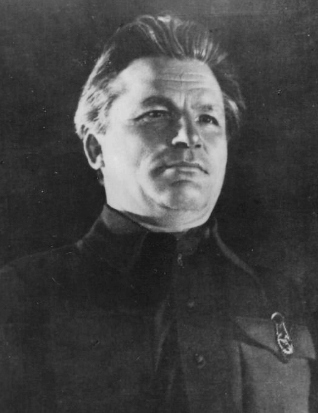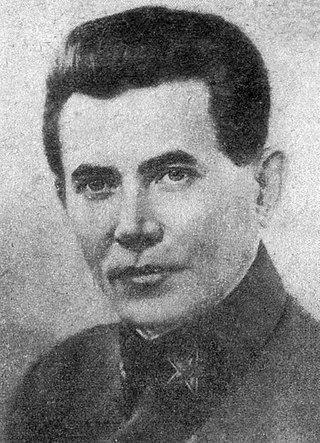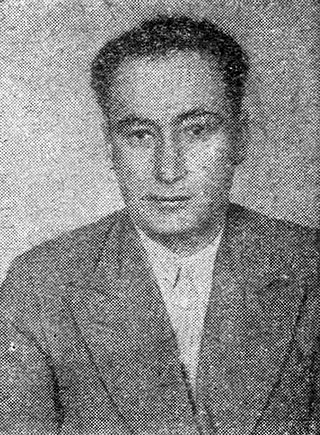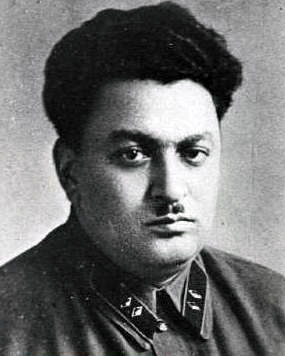
Lavrentiy Pavlovich Beria was a Georgian Bolshevik and Soviet politician, Marshal of the Soviet Union and state security administrator, chief of the Soviet security, and chief of the People's Commissariat for Internal Affairs (NKVD) under Joseph Stalin during the Second World War, and promoted to deputy premier under Stalin in 1941. He officially joined the Politburo in 1946. Beria was the longest-lived and most influential of Stalin's secret police chiefs, wielding his most substantial influence during and after the war. Following the Soviet invasion of Poland in 1939, he was responsible for organising purges such as the Katyn massacre of 22,000 Polish officers and officials.

Sergei Mironovich Kirov was a Russian and Soviet politician and Bolshevik revolutionary.

The Great Purge or the Great Terror, also known as the Year of '37 and the Yezhovshchina, was Soviet General Secretary Joseph Stalin's campaign to solidify his power over the Communist Party of the Soviet Union and the state; the purges were also designed to remove the remaining influence of Leon Trotsky as well as other prominent political rivals within the party. It occurred from August 1936 to March 1938.

The Armenian Soviet Socialist Republic, also known as Soviet Armenia, or simply Armenia, was one of the constituent republics of the Soviet Union, located in the Caucasus region of Eurasia. Soviet Armenia bordered the Soviet Republics of Azerbaijan and Georgia and the independent states of Iran and Turkey. The capital of the republic was Yerevan and it contained thirty-seven districts (raions). Other major cities in the ArmSSR included Leninakan, Kirovakan, Hrazdan, Etchmiadzin, and Kapan. The republic was governed by Communist Party of Armenia, a branch of the main Communist Party of the Soviet Union.

Anastas Ivanovich Mikoyan was an Armenian Communist revolutionary, Old Bolshevik and Soviet statesman. Having been elected to the Central Committee in 1923, he was the only Soviet politician who managed to remain at the highest levels of power within the Communist Party from the latter days of Lenin, through the eras of Stalin and Khrushchev, to his peaceful retirement under Brezhnev.

Nikolai Ivanovich Yezhov was a Soviet secret police official under Joseph Stalin who was head of the NKVD from 1936 to 1938, during the height of the Great Purge. Yezhov organized mass arrests, torture and executions during the Great Purge, but he fell from Stalin's favour and was arrested, subsequently admitting in a confession to a range of anti-Soviet activity including "unfounded arrests" during the Purge. He was executed in 1940 along with others who were blamed for the Purge.

An index of articles related to the former nation known as the Soviet Union. It covers the Soviet revolutionary period until the dissolution of the Soviet Union. This list includes topics, events, persons and other items of national significance within the Soviet Union. It does not include places within the Soviet Union, unless the place is associated with an event of national significance. This index also does not contain items related to Soviet Military History.
Mass operations of the People's Comissariate of Internal Affairs (NKVD) were carried out during the Great Purge and targeted specific categories of people. As a rule, they were carried out according to the corresponding order of the People's Commissar of Internal Affairs Nikolai Yezhov.

Sergei Nikiforovich Kruglov was the Minister of Internal Affairs of the Soviet Union from January 1946 to March 1953 and again from June 1953 until February 1956. He held the military rank of Colonel General. He was involved in several brutal actions of the Soviet security forces. These actions occurred in the 1940s and were carried out alongside his comrade-in-arms General Ivan Serov.

Yeghishe Charents was an Armenian poet, writer and public activist. Charents' literary subject matter ranged from his experiences in the First World War, the Russian Revolution, and frequently Armenia and Armenians. He is recognized as "the main poet of the 20th century" in Armenia.

Mikhail Petrovich Frinovsky was a Soviet secret police official who served as a deputy head of the NKVD under Nikolai Yezhov during the Great Purge.

Grigory Artemievich Arutinov or Grigor Artemi Harutyunyan was the First Secretary of the Communist Party of the Armenian SSR from 24 September 1937 to 12 March 1953. His tenure as first secretary was the longest in the history of the Armenian SSR.

Aghasi Ghevondi Khanjian was First Secretary of the Communist Party of Armenia from May 1930 to July 1936.

Alexander Fyodori Miasnikian or Myasnikov, also known by his revolutionary nom de guerreMartuni, was an Armenian Bolshevik revolutionary, military leader and politician. During the Russian Civil War, he served as First Secretary of the Communist Party of Byelorussia from 1918 to 1919. As the Chairman of the Council of People's Commissars of Armenia from 1921 to 1922, he is credited with rebuilding the Armenian republic at the beginning of Lenin's New Economic Policy (NEP).

Khoren I Muradbekian was an Armenian Apostolic religious figure who served as Catholicos of All Armenians from 1932 until his murder in 1938. He previously served as locum tenens, between 1923 and 1932, in the latter years of and after the death of Catholicos Gevorg V, and bishop of Yerevan from 1910 to 1924.

Bogdan Zakharovich Kobulov served as a senior member of the Soviet security- and police-apparatus during the rule of Joseph Stalin. After Stalin's death he was arrested and executed along with his former chief and patron Lavrentiy Beria.
De-Stalinization comprised a series of political reforms in the Soviet Union after the death of long-time leader Joseph Stalin in 1953, and the thaw brought about by ascension of Nikita Khrushchev to power, and his 1956 secret speech "On the Cult of Personality and Its Consequences", which denounced Stalin's cult of personality and the Stalinist political system.

The Death of Stalin is a 2017 political satire black comedy film written and directed by Armando Iannucci and co-written by David Schneider and Ian Martin with Peter Fellows. Based on the French graphic novel La Mort de Staline (2010–2012), the film depicts the internal social and political power struggle among the members of Council of Ministers following the death of Soviet leader Joseph Stalin in 1953. The French-British-Belgian co-production stars an ensemble cast that includes Steve Buscemi, Simon Russell Beale, Paddy Considine, Rupert Friend, Jason Isaacs, Olga Kurylenko, Michael Palin, Andrea Riseborough, Dermot Crowley, Paul Chahidi, Adrian McLoughlin, Paul Whitehouse, and Jeffrey Tambor.

Amatuni Simoni Amatuni, born Amatuni Vardapetyan, was a Soviet Armenian politician who served as First Secretary of the Communist Party of Armenia from 1936 to 1937. Born in Yelisavetpol (Ganja), Elizavetpol uezd, Elizavetpol Governorate, Russian Empire, he became a member of the Bolshevik Party in 1919. From 1926 to 1928 he studied at the Institute of Red Professors, then held various party positions in Yerevan, Tiflis, and Baku. An ally of Lavrentiy Beria, he served as Second Secretary of the Communist Party of Armenia from 1935 to 1936, then became First Secretary in 1936 after the death of his predecessor Aghasi Khanjian. With Armenian NKVD chief Khachik Mughdusi, Amatuni oversaw the initial part of the Great Purge in Armenia, before his own arrest on 23 September 1937. He appeared on Stalin's execution list of 26 July 1938 and was shot the same day.

Gevork Sarkisovich Alikhanyan (1897–1938), also known in Russian as Georgy Alikhanov, was a Soviet Armenian politician and statesman. Alikhanyan is best known for being the founding First Secretary of the Communist Party of Armenia from 1920 to 1921. He was also a high-ranking member of Comintern before his arrest and execution during the Great Purge.


































